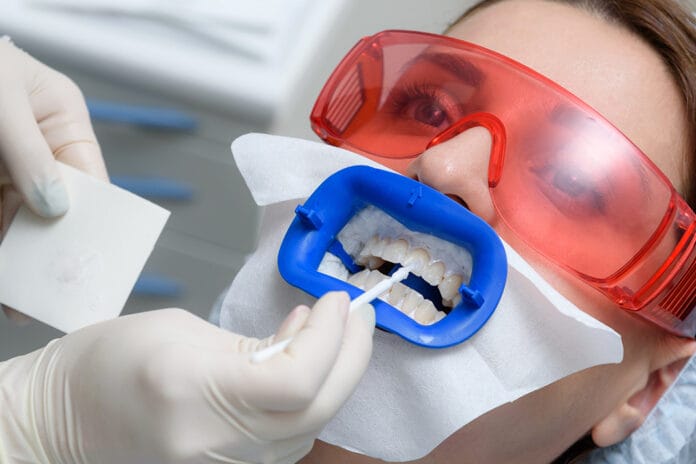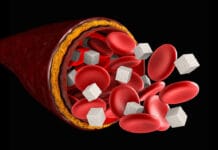Almost every patient visiting a dental hygienist wants whiter teeth. I wish I had a dollar for every chief complaint that I described as “wants whiter teeth.” So many whitening options are available ‒ gels, strips, toothpaste, mouth rinses, and, of course, in-office treatments.
How do dental hygienists decide the best recommendation for patients seeking a whiter and brighter smile?
Whitening Systems
Whitening systems are categorized based on factors such as the whitening agent used, concentration, application form, and frequency. The two main groups that exist are in-office and at-home systems.1
In-office treatments conducted by dental professionals use high oxidant concentrations like 25% or 35% hydrogen peroxide for short durations. Soft tissues are protected with barriers, and eye protection is essential if the product is light-activated due to its intensity. Advantages include immediately visible results but require multiple applications. Disadvantages include high cost, chair time, possible need for combination with at-home methods, and teeth hypersensitivity.1
At-home systems are commercially available, affordable, and user-friendly. They can be professionally supervised or over-the-counter (OTC) products, and these options include professionally supervised whitening trays with gel, toothpaste, mouth rinses, whitening strips, and whitening gels.1
Toothpaste
Toothpaste is often the go-to for patients seeking whiter teeth. There are many options, and they are relatively inexpensive and can be obtained OTC. These patients often fall for marketing ploys and claims that are simply not supported by evidence.
Charcoal Toothpaste
A study was recently published on the efficacy of charcoal-based toothpaste. The study examined the effects of three charcoal-based whitening toothpastes in comparison with regular fluoridated toothpaste, focusing on color change, surface roughness, and microhardness. Charcoal-based whitening toothpastes allege to work through adsorption due to the porous nature of charcoal, which can bind to pigments responsible for tooth discoloration.2
Despite the availability, few studies have compared commercially available charcoal toothpaste products. In vitro techniques using substances such as chlorhexidine, coffee, red wine, and black tea were employed to assess whitening efficacy in this study.2 The results indicated none of the tested toothpaste, including charcoal-based and regular fluoridated, showed significant whitening effects after 12 weeks of brushing.2
Research on the whitening potential of charcoal toothpaste has yielded varied results. Some studies found no significant whitening effect, while others observed slight whitening. However, charcoal toothpaste’s abrasive potential raises concerns about its impact on tooth surface roughness. Surface roughness is crucial as it can impact bacterial adhesion, biofilm formation, and various dental issues.2
In another review published, the researchers highlighted that only 28% of charcoal toothpastes are low in abrasiveness. This study found that surface roughness increased significantly for most charcoal toothpaste except one with low abrasive content.2,3
Based on these studies, dental professionals should not recommend charcoal-based toothpaste for whitening. Charcoal-based toothpaste does not whiten teeth; however, it does increase the surface roughness of enamel.
Purple Toothpaste
The active ingredient in purple toothpaste is blue covarine. The whitening mechanism of the blue covarine toothpaste involves depositing a thin, semi-transparent film onto enamel surfaces, causing a color shift from yellow to blue and creating an illusion of whiter teeth. However, the efficacy and safety of this approach have shown mixed results.4
In a double-blind, randomized control trial, participants used the blue covarine toothpaste for two weeks, comparing it with at-home bleaching and conventional toothpaste. Tooth shade measurements and color parameter values were recorded using colorimeter techniques. The results indicated that the blue covarine toothpaste group had color changes like the conventional toothpaste group, with both groups showing significantly lower color changes than the at-home bleaching group.4
In studies that report a color shift from a yellow hue to a bluer hue, the change did not persist after the treatment period. This suggests the toothpaste deposits pigment on the enamel surface resulting in an instant color change. However, the pigment wears off over time, requiring continuous use to achieve the illusion of whiter teeth.4
The takeaway is that purple toothpaste can provide an illusion of whiter teeth as long as the use is continuous. But there is no real change in tooth color, as is seen with other bleaching products, such as products with hydrogen peroxide.
Other Whitening Toothpastes
Several studies have indicated the effectiveness of toothpaste with components such as baking soda, peroxide, amorphous calcium phosphate, and tetrasodium pyrophosphate as whitening agents. These toothpastes tend to remove extrinsic stains effectively yet leave a bit to be desired when trying to tackle intrinsic stains.
When compared to OTC whitening strips, whitening toothpaste is not comparable. OTC whitening strips are superior to whitening toothpaste for significant color change.5
Over-the-Counter Whitening
Toothpaste is not the only OTC whitening option. Whitening strips and paint-on varnishes/gels are also options.
Whitening Strips
When compared to tooth whitening strips, toothpastes were less effective. A study comparing whitening toothpaste to strips found significant changes with strips but not with toothpaste.5
A literature review analyzed seven studies on whitening strips, comparing them with placebos, carbamide peroxide trays, or different concentrations of whitening strips. Studies included hydrogen peroxide concentrations of 5% to 6.5% and 9.5% to 14% with exposure times of 30 minutes twice daily.5
Two studies found significant shade improvement with whitening strips compared to placebos. Four studies concluded that strips were as effective as carbamide peroxide trays, and one study indicated the superiority of 6% hydrogen peroxide strips over 10% carbamide peroxide gel trays. Notably, increased exposure time led to better results in two high-quality studies. Overall, whitening strips were effective in most studies compared to other over-the-counter whitening agents.5
Paint-on Varnishes and Gels
There are limited studies evaluating the efficacy of paint-on varnishes and gels. However, among the two studies published, both studies concluded, to varying extents, that paint-on gels were effective for tooth whitening. A systematic review suggested that thrice-daily application of paint-on gels was more effective than twice daily, and higher hydrogen peroxide percentages were more effective.5
Despite reported effectiveness, the limited evidence makes declaring paint-on gel’s efficacy for whitening challenging.5
Whitening Rinses
Whitening mouth rinses are quick and easy to use, making them an enticing choice for whitening. But are they effective?
An in vitro study was conducted to compare the effectiveness of commercially available mouth rinses containing hydrogen peroxide and 10% carbamide peroxide whitening gel.6 The study revealed that immersion time significantly influenced tooth whitening. In this study, immersion time for mouth rinses was a total of four minutes per day for 7, 28, and 56 days. The most improvement was seen in the first 7 to 28 days. After 28 days, improvements plateaued, and no further whitening was observed. Literature on the effectiveness of whitening mouth rinses is contradictory, and some studies report similarities to 10% carbamide peroxide gel and others.6
This study found that the mouth rinses resulted in lower color changes compared to 10% carbamide peroxide gel, yet higher than the negative control. Home bleaching with 10% carbamide peroxide gel was the most effective, demonstrating stable and long-lasting results.6
Ultimately, this study demonstrated that each tested mouth rinse effectively whitened stained teeth over time, although none were as effective as the 10% carbamide peroxide at-home bleaching gel. Color changes varied based on the specific parameters analyzed. This study was done in vitro, which has limitations.6
Professional Whitening
By far, the most effective way to whiten teeth is through professional whitening systems. These systems vary as some are in-office while others are at-home. Additionally, some require light activation while others do not.
However, some of these can be quite pricey and may not always be the best option for patients. Let’s explore their efficacy.
Tray Delivered At-home Whitening
A systematic review and meta-analysis examining the efficacy of whitening between carbamide peroxide and hydrogen peroxide at-home whitening gels found that carbamide peroxide whitening gel may provide slightly better results. The authors determined this was likely due to carbamide peroxide’s slower release of the active hydrogen peroxide. Nonetheless, there was not a significant difference in tooth whitening between the two products.7
At-home tray-delivered whitening gel can be found in multiple concentrations. A randomized clinical trial evaluating the safety and efficacy of 10% and 16% carbamide peroxide determined that despite the higher concentration, the efficacy of 16% carbamide peroxide was not significantly different from 10% carbamide peroxide. Safety-wise, 10% carbamide peroxide was better tolerated, with fewer instances of gingival irritation, compared to 16% carbamide peroxide.8
The higher concentration did indeed yield quicker results. Therefore, if you have a patient in need of quick results, a higher concentration may be a better choice. However, the study concluded that both concentrations were equally effective in improving tooth shade after three weeks of at-home bleaching.8
In-office Whitening
Multiple in-office whitening systems require light activation, but others do not. Is there a difference between these two methods?
A randomized controlled trial was completed to evaluate the efficacy of color change and sensitivity after in-office whitening with and without light activation. Patients were randomly assigned to two different groups:9
- Group A: In-office whitening with light-activated 25% hydrogen peroxide gel followed by two weeks at home, night-time whitening with 10% carbamide peroxide gel in a customized whitening tray.
- Group B: In-office whitening with 25% hydrogen peroxide without light activation followed by two weeks at home, night-time whitening with 10% carbamide peroxide gel in a customized bleaching tray.
The results indicated no significant difference in shade improvement or sensitivity between the two whitening protocols tested during the two-week study period. Though there were limitations in this clinical trial, such as a small sample size and the operator was not blinded, the results still provide valuable information for those using in-office whitening systems because it shows efficacy among both products.9
Conclusion
Though professional whitening options are superior to most OTC options, the price can be an obstacle for many patients. Knowing the efficacy of products that patients may inquire about is important in helping them to avoid gimmicks. In some cases, the only option for improvement may be professional, in-office whitening. However, for patients who struggle with mild extrinsic and intrinsic stains, toothpaste with peroxide and baking soda, OTC whitening strips, mouth rinses with hydrogen peroxide, and at-home whitening trays may be effective.
To effectively change the shade of teeth with moderate to heavy intrinsic stains, a chemical reaction is required. This means that patients with this level of stain will need products with hydrogen peroxide with extended exposure to see good results. This would require in-office whitening, whitening trays, or strips.
With the number of oral care products that hit the shelves every year, it can be difficult to know all the details and which product is best for your patients. Hopefully, this information will help you have a more productive conversation with patients looking to whiten their smiles while also providing your patients with the best options for the improvement they wish to achieve.
Before you leave, check out the Today’s RDH self-study CE courses. All courses are peer-reviewed and non-sponsored to focus solely on high-quality education. Click here now.
Listen to the Today’s RDH Dental Hygiene Podcast Below:
References
- Rodríguez-Martínez, J., Valiente, M., Sánchez-Martín, M.J. Tooth Whitening: From the Established Treatments to Novel Approaches to Prevent Side Effects.Journal of Esthetic and Restorative Dentistry. 2019; 31(5): 431-440. https://doi.org/10.1111/jerd.12519
- Koc Vural, U., Bagdatli, Z., Yilmaz, A.E., et al. Effects of Charcoal-based Whitening Toothpastes on Human Enamel in Terms of Color, Surface Roughness, and Microhardness: An In Vitro Study.Clinical Oral Investigations. 2021;25(10): 5977-5985. https://doi.org/10.1007/s00784-021-03903-x
- Brooks, J.K., Bashirelahi, N., Reynolds, M.A. Charcoal and Charcoal-based Dentifrices: A Literature Review. J Am Dent Assoc. 2017; 148: 661-670. https://jada.ada.org/article/S0002-8177(17)30412-9/fulltext
- Meireles, S.S., de Sousa, J.P., Lins, R.B.E., Sampaio, F.C. Efficacy of Whitening Toothpaste Containing Blue Covarine: A Double-blind Controlled Randomized Clinical Trial.Journal of Esthetic and Restorative Dentistry. 2021;33(2): 341-350. https://doi.org/10.1111/jerd.12605
- Naidu, A.S., Bennani, V., Brunton, J.M A.P., Brunton, P. Over-the-Counter Tooth Whitening Agents: A Review of Literature.Brazilian Dental Journal. 2020;31(3): 221–235. https://doi.org/10.1590/0103-6440202003227
- Karadas, M., Hatipoglu, O. Efficacy of Mouthwashes Containing Hydrogen Peroxide on Tooth Whitening.The Scientific World Journal. 2015;2015: 961403. https://doi.org/10.1155/2015/961403
- Luque-Martinez, I., Reis, A., Schroeder, M., et al. Comparison of Efficacy of Tray-delivered Carbamide and Hydrogen Peroxide for At-home Bleaching: A Systematic Review and Meta-analysis.Clinical Oral Investigations. 2016; 20(7): 1419-1433. https://doi.org/10.1007/s00784-016-1863-7
- Meireles, S.S., Heckmann, S.S., Leida, F.L., et al. Efficacy and Safety of 10% and 16% Carbamide Peroxide Tooth-whitening Gels: A Randomized Clinical Trial.Operative Dentistry. 2008;33(6): 606-612. https://doi.org/10.2341/07-150
- Nutter, B.J., Sharif, M.O., Smith, A.B., Brunton, P.A. A Clinical Study Comparing the Efficacy of Light Activated In-surgery Whitening versus In-surgery Whitening without Light Activation.Journal of Dentistry. 2013;41(Suppl 5): e3-e7. https://doi.org/10.1016/j.jdent.2013.03.004











